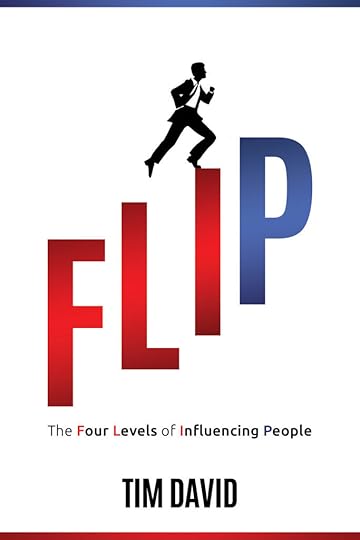The Absolute BEST Way to Make Hard Decisions
Influential people are decisive. They make decisions quickly and they change them slowly.
The video above walks you through a six-step process that I used to choose a new cover design for my book, FLIP: The Four Levels of Influencing People. But fast decision-making applies to every area of our lives.
A parent who is clear and firm (with love) has more influence over their child’s behavior than an indecisive parent who lacks consistency. A top executive who makes decisions quickly and changes them slowly will inspire their team to action. An indecisive leader who is always changing directions won’t inspire confidence in anyone. An entrepreneur who makes decisions well and sticks to them will be more successful than an entrepreneur who chases every shiny object that comes along.
Fast decisions are clearly important for success in this world, but how can we be certain we’ve made the right one? Especially when we feel stuck between a rock and a hard place. Brain science to the rescue! I use a six-part thinking method that taps into the amazing decision-making ability of the human brain – even when people disagree.
IBM says this cut the time they spent in meetings by 75%. In one experiment, this method increased thinking productivity in groups by 493%. (Source: Edward de Bono, Six Thinking Hats)
1. Planning (Blue hat)
First you’ve got to think about what you’ll be thinking about. What is the decision that needs to be made? Who needs to be involved? (Do they really need to be involved in this meeting or is it just some ridiculous “positional requirement”?) How much time do you have to make this decision?
If you’re making a decision as a group, then one of you needs to continue using this type of meta-thinking. We’ll call this person the facilitator. The facilitator keeps everyone else on point throughout the entire process.
2. Facts (White hat)
Now it’s time to look at what you know. Lay all the facts out on the table. This is not the time for opinions or interpretations. Try to remain neutral here. Just the facts, Ma’am.
Facts can vary in degree from absolutely certain to not yet fully checked. Get in the habit of checking facts with a simple, “Are we SURE about that?” Some “facts” might turn out to just be assumptions.
3. Pros (Yellow hat)
This is where you identify the positives of the decision in both present AND future tense. For example, if you were using this method to decide whether or not to hire someone, you’d look at the present (What are this applicant’s BEST qualities?) AND the future (What are all the great things that will happen if we hire this person?)
So if I were to compare this to a SWOT analysis, then this step would encompass not just the ‘S – Strengths,’ but also the ‘O – Opportunities’. The ‘W’ and ‘T’ are saved for the next step.
4. Cons (Black hat)
Okay all you Negative Nelly’s and Debbie Downers, it’s your time to shine! What are the “Weaknesses” and potential “Threats” (Re: The ‘W’ and ‘T’ taken from the SWOT analysis mentioned above) for a given decision? This is the time to slow down and be cautious about moving forward. Keep your critical thinking skills handy.
It’s great to be positive, but effective decisions can’t be made if you only look at one side of the coin. By looking at pros AND cons, you force both optimists and pessimists to see and value each others’ opinions.
I like doing a “pre-mortem” for this step. To do that, I imagine that I’ve time-traveled to the future where I see that my decision turns out to be a disaster. I make it very real in my mind. Then I ask myself, “What made it all go wrong?” It’s amazing the cracks that a pre-mortem will help you to discover.
5. Feelings (Red hat)
“What is your gut telling you?” is a question that isn’t asked nearly enough. When doing this type of thinking, don’t ever try to justify or judge your emotions, just let them flow. Often times, that gut feeling is our brain’s way of warning us against a bad decision, or perhaps pushing us toward something beneficial.
Don’t ignore your feelings, but don’t put too much stock in them either. Remember, each of these steps is only one sixth of the entire decision-making equation.
6. Brainstorm (Green hat)
There are times when you’ll go through all five steps and still not have a solid decision. Perhaps the right option for you hasn’t been discovered yet. Maybe you were trying to decide between “A” and “B” when “C” would have been better than both of them.
There has been a lot written about brainstorming and lateral thinking. One of the keys to doing this effectively is to focus on the quantity of ideas and not the quality. Don’t filter any ideas, don’t dismiss any ideas, and don’t judge any ideas. You can do all that later. Another key for great creative input is to use prompting tools. Something like Rory’s Story Cubes is a great example of a prompting tool. You can also write random words on a stack of index cards, shuffle them all together, and then draw cards one at a time as prompts.
The idea is to generate some kind of prompt at random, and then see where the prompt takes your thoughts! You’d be surprised at how insight can come from the strangest places.
Wrapping it all up
By doing these six steps, not only have you factored in everyone’s opinions and perspectives and given everyone a voice, but you also challenged yourself to think about the decision from every possible angle. Whatever decision you make will be firm in your mind and you will be MUCH less likely to experience any kind of regret.
While no one can predict the future and things may still go wrong, at least you’ll be able to confidently say. “I made the best decision with the information I had at the time.” And what more can you ask for than that?
Here is the final version of the cover I chose:

What do you think?
Comment below with a tough decision (personally or professionally) that you’ll use the six thinking hats on.
The post The Absolute BEST Way to Make Hard Decisions appeared first on GoodAtPeople.com.



